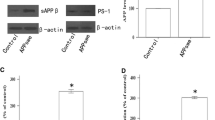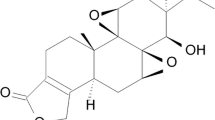Abstract
The synthetic Liver X receptor (LXR) activator T0901317 has been reported to exert neuroprotective effect in Alzheimer’s disease, but the relationship between LXR activation and beta-site amyloid precursor protein cleaving enzyme 1 (BACE-1) remains uncertain. This study investigated the effect of T0901317 on membrane cholesterol levels, BACE1 expression and activity. We found that T0901317 decreased membrane cholesterol levels, reduced BACE1 expression and activity as well as β-secretase cleaved C-terminal fragment (β-CTF) levels in vivo and in vitro. Meanwhile, the expression of ATP-binding membrane cassette transport protein A1 (ABCA1) enhanced. Additionally, inhibition of ABCA1 abrogated the effects of T0901317 on membrane cholesterol levels and β-secretase activity. Moreover, addition of LXR antagonist reversed the effect of T0901317 on ABCA1 mRNA expression, membrane cholesterol levels and β-secretase activity. Our results suggest that activation of LXR may decrease BACE1 expression and activity through a pathway associated with ABCA1-mediated reduction in membrane cholesterol levels.








Similar content being viewed by others
References
Selkoe DJ (2001) Alzheimer’s disease results from the cerebral accumulation and cytotoxicity of amyloid beta-protein. J Alzheimers Dis 3:75–80
Vassar R, Bennett BD, Babu-Khan S et al (1999) Beta-secretase cleavage of Alzheimer’s amyloid precursor protein by the transmembrane aspartic protease BACE. Science 286:735–741
Yan R, Han P, Miao H et al (2001) The transmembrane domain of the Alzheimer’s beta-secretase (BACE1) determines its late Golgi localization and access to beta-amyloid precursor protein (APP) substrate. J Biol Chem 276:36788–36796
Selkoe DJ (1994) Normal and abnormal biology of the beta-amyloid precursor protein. Annu Rev Neurosci 17:489–517
Asai M, Hattori C, Iwata N et al (2006) The novel beta-secretase inhibitor KMI-429 reduces amyloid beta peptide production in amyloid precursor protein transgenic and wild-type mice. J Neurochem 96:533–540
Hussain I, Hawkins J, Harrison D et al (2007) Oral administration of a potent and selective non-peptidic BACE-1 inhibitor decreases beta-cleavage of amyloid precursor protein and amyloid-beta production in vivo. J Neurochem 100:802–809
Kimura R, Devi L, Ohno M (2010) Partial reduction of BACE1 improves synaptic plasticity, recent and remote memories in Alzheimer’s disease transgenic mice. J Neurochem 113:248–261
Casserly I, Topol E (2004) Convergence of atherosclerosis and Alzheimer’s disease: inflammation, cholesterol, and misfolded proteins. Lancet 363:1139–1146
Thirumangalakudi L, Prakasam A, Zhang R et al (2008) High cholesterol-induced neuroinflammation and amyloid precursor protein processing correlate with loss of working memory in mice. J Neurochem 106:475–485
Hooijmans CR, Van der Zee CE, Dederen PJ et al (2009) DHA and cholesterol containing diets influence Alzheimer-like pathology, cognition and cerebral vasculature in APPswe/PS1dE9 mice. Neurobiol Dis 33:482–498
Kivipelto M, Helkala EL, Laakso MP et al (2001) Midlife vascular risk factors and Alzheimer’s disease in later life: longitudinal, population based study. BMJ 322:1447–1451
Puglielli L, Tanzi RE, Kovacs DM (2003) Alzheimer’s disease: the cholesterol connection. Nat Neurosci 6:345–351
Ghribi O, Larsen B, Schrag M et al (2006) High cholesterol content in neurons increases BACE, beta-amyloid, and phosphorylated tau levels in rabbit hippocampus. Exp Neurol 200:460–467
Ullrich C, Pirchl M, Humpel C (2010) Hypercholesterolemia in rats impairs the cholinergic system and leads to memory deficits. Mol Cell Neurosci 45(4):408–417
Refolo LM, Pappolla MA, LaFrancois J et al (2001) A cholesterol-lowering drug reduces beta-amyloid pathology in a transgenic mouse model of Alzheimer’s disease. Neurobiol Dis 8:890–899
Chauhan NB, Siegel GJ, Feinstein DL (2004) Effects of lovastatin and pravastatin on amyloid processing and inflammatory response in TgCRND8 brain. Neurochem Res 29:1897–1911
Cordy JM, Hussain I, Dingwall C et al (2003) Exclusively targeting beta-secretase to lipid rafts by GPI-anchor addition up-regulates beta-site processing of the amyloid precursor protein. Proc Natl Acad Sci USA 100:11735–11740
Whitney KD, Watson MA, Collins JL et al (2002) Regulation of cholesterol homeostasis by the liver X receptors in the central nervous system. Mol Endocrinol 16:1378–1385
Sun Y, Yao J, Kim TW et al (2003) Expression of liver X receptor target genes decreases cellular amyloid beta peptide secretion. J Biol Chem 278:27688–27694
Liang Y, Lin S, Beyer TP et al (2004) A liver X receptor and retinoid X receptor heterodimer mediates apolipoprotein E expression, secretion and cholesterol homeostasis in astrocytes. J Neurochem 88:623–634
Repa JJ, Mangelsdorf DJ (2002) The liver X receptor gene team: potential new players in atherosclerosis. Nat Med 8:1243–1248
Eckert GP, Vardanian L, Rebeck GW et al (2007) Regulation of central nervous system cholesterol homeostasis by the liver X receptor agonist TO-901317. Neurosci Lett 423:47–52
Repa JJ, Li H, Frank-Cannon TC et al (2007) Liver X receptor activation enhances cholesterol loss from the brain, decreases neuroinflammation, and increases survival of the NPC1 mouse. J Neurosci 27:14470–14480
Koldamova RP, Lefterov IM, Staufenbiel M et al (2005) The liver X receptor ligand T0901317 decreases amyloid beta production in vitro and in a mouse model of Alzheimer’s disease. J Biol Chem 280:4079–4088
Lefterov I, Bookout A, Wang Z et al (2007) Expression profiling in APP23 mouse brain: inhibition of Abeta amyloidosis and inflammation in response to LXR agonist treatment. Mol Neurodegener 2:20
Riddell DR, Zhou H, Comery TA et al (2007) The LXR agonist TO901317 selectively lowers hippocampal Abeta42 and improves memory in the Tg2576 mouse model of Alzheimer’s disease. Mol Cell Neurosci 34:621–628
Zelcer N, Khanlou N, Clare R et al (2007) Attenuation of neuroinflammation and Alzheimer’s disease pathology by liver x receptors. Proc Natl Acad Sci USA 104:10601–10606
Jiang Q, Lee CY, Mandrekar S et al (2008) ApoE promotes the proteolytic degradation of Abeta. Neuron 58:681–693
Zelcer N, Tontonoz P (2006) Liver X receptors as integrators of metabolic and inflammatory signaling. J Clin Invest 116:607–614
Chen G, Bower KA, Ma C et al (2004) Glycogen synthase kinase 3beta (GSK3beta) mediates 6-hydroxydopamine-induced neuronal death. FASEB J 18:1162–1164
Cecchi C, Rosati F, Pensalfini A et al (2008) Seladin-1/DHCR24 protects neuroblastoma cells against Abeta toxicity by increasing membrane cholesterol content. J Cell Mol Med 12:1990–2002
Neufeld EB, Cooney AM, Pitha J et al (1996) Intracellular trafficking of cholesterol monitored with a cyclodextrin. J Biol Chem 271:21604–21613
Smith JD, Le Goff W, Settle M et al (2004) ABCA1 mediates concurrent cholesterol and phospholipid efflux to apolipoprotein A-I. J Lipid Res 45:635–644
Fielding PE, Nagao K, Hakamata H et al (2000) A two-step mechanism for free cholesterol and phospholipid efflux from human vascular cells to apolipoprotein A-1. Biochemistry 39:14113–14120
Wang N, Silver DL, Thiele C et al (2001) ATP-binding cassette transporter A1 (ABCA1) functions as a cholesterol efflux regulatory protein. J Biol Chem 276:23742–23747
Forman BM, Ruan B, Chen J et al (1997) The orphan nuclear receptor LXRalpha is positively and negatively regulated by distinct products of mevalonate metabolism. Proc Natl Acad Sci USA 94:10588–10593
Gan X, Kaplan R, Menke JG et al (2001) Dual mechanisms of ABCA1 regulation by geranylgeranyl pyrophosphate. J Biol Chem 276:48702–48708
Vanmierlo T, Rutten K, Dederen J et al (2009) Liver X receptor activation restores memory in aged AD mice without reducing amyloid. Neurobiol Aging [Epub ahead of print]
Fitz NF, Cronican A, Pham T et al (2010) Liver X receptor agonist treatment ameliorates amyloid pathology and memory deficits caused by high-fat diet in APP23 mice. J Neurosci 30:6862–6872
Tamagno E, Parola M, Bardini P et al (2005) Beta-site APP cleaving enzyme up-regulation induced by 4-hydroxynonenal is mediated by stress-activated protein kinases pathways. J Neurochem 92:628–636
Sun X, He G, Qing H et al (2006) Hypoxia facilitates Alzheimer’s disease pathogenesis by up-regulating BACE1 gene expression. Proc Natl Acad Sci USA 103:18727–18732
Zhiyou C, Yong Y, Shanquan S et al (2009) Upregulation of BACE1 and beta-Amyloid Protein Mediated by Chronic Cerebral Hypoperfusion Contributes to Cognitive Impairment and Pathogenesis of Alzheimer’s Disease. Neurochem Res 34(7):1226–1235
Ehehalt R, Keller P, Haass C et al (2003) Amyloidogenic processing of the Alzheimer beta-amyloid precursor protein depends on lipid rafts. J Cell Biol 160:113–123
Wolozin B (2004) Cholesterol and the biology of Alzheimer’s disease. Neuron 41:7–10
Koldamova RP, Lefterov IM, Ikonomovic MD et al (2003) 22R-hydroxycholesterol and 9-cis-retinoic acid induce ATP-binding cassette transporter A1 expression and cholesterol efflux in brain cells and decrease amyloid beta secretion. J Biol Chem 278:13244–13256
Wang N, Tall AR (2003) Regulation and mechanisms of ATP-binding cassette transporter A1-mediated cellular cholesterol efflux. Arterioscler Thromb Vasc Biol 23:1178–1184
Rossner S, Sastre M, Bourne K et al (2006) Transcriptional and translational regulation of BACE1 expression—implications for Alzheimer’s disease. Prog Neurobiol 79:95–111
Fukumoto H, Cheung BS, Hyman BT et al (2002) Beta-secretase protein and activity are increased in the neocortex in Alzheimer disease. Arch Neurol 59:1381–1389
Holsinger RM, McLean CA, Beyreuther K et al (2002) Increased expression of the amyloid precursor beta-secretase in Alzheimer’s disease. Ann Neurol 51:783–786
Aleshkov S, Abraham CR, Zannis VI (1997) Interaction of nascent ApoE2, ApoE3, and ApoE4 isoforms expressed in mammalian cells with amyloid peptide beta (1–40). Relevance to Alzheimer’s disease. Biochemistry 36:10571–10580
Huttunen HJ, Peach C, Bhattacharyya R et al (2009) Inhibition of acyl-coenzyme A: cholesterol acyl transferase modulates amyloid precursor protein trafficking in the early secretory pathway. FASEB J 23:3819–3828
Saluja I, Paulson H, Gupta A et al (2009) X11alpha haploinsufficiency enhances Abeta amyloid deposition in Alzheimer’s disease transgenic mice. Neurobiol Dis 36:162–168
Xiong M, Zhang T, Zhang LM et al (2008) Caspase inhibition attenuates accumulation of beta-amyloid by reducing beta-secretase production and activity in rat brains after stroke. Neurobiol Dis 32:433–441
Liang X, Wang Q, Hand T et al (2005) Deletion of the prostaglandin E2 EP2 receptor reduces oxidative damage and amyloid burden in a model of Alzheimer’s disease. J Neurosci 25:10180–10187
Li L, Zhang X, Yang D et al (2009) Hypoxia increases Abeta generation by altering beta- and gamma-cleavage of APP. Neurobiol Aging 30:1091–1098
Chevallier N, Vizzavona J, Marambaud P et al (1997) Cathepsin D displays in vitro beta-secretase-like specificity. Brain Res 750:11–19
Gruninger-Leitch F, Schlatter D, Kung E et al (2002) Substrate and inhibitor profile of BACE (beta-secretase) and comparison with other mammalian aspartic proteases. J Biol Chem 277:4687–4693
Andrau D, Dumanchin-Njock C, Ayral E et al (2003) BACE1- and BACE2-expressing human cells: characterization of beta-amyloid precursor protein-derived catabolites, design of a novel fluorimetric assay, and identification of new in vitro inhibitors. J Biol Chem 278:25859–25866
Wang X, Su B, Siedlak SL et al (2008) Amyloid-beta overproduction causes abnormal mitochondrial dynamics via differential modulation of mitochondrial fission/fusion proteins. Proc Natl Acad Sci USA 105:19318–19323
Fan X, Luo G, Yang D et al (2010) Critical role of lysosome and its associated protein cathepsin D in manganese-induced toxicity in cultured midbrain astrocyte. Neurochem Int 56:291–300
Colella R, Lu G, Glazewski L et al (2010) Induction of cell death in neuroblastoma by inhibition of cathepsins B and L. Cancer Lett 294:195–203
Acknowledgments
The authors would like to express thanks to Prof. Guomin Zhou and Prof. Zulin Chen for introducing the animal model into our laboratory.
Author information
Authors and Affiliations
Corresponding authors
Rights and permissions
About this article
Cite this article
Cui, W., Sun, Y., Wang, Z. et al. Activation of Liver X Receptor Decreases BACE1 Expression and Activity by Reducing Membrane Cholesterol Levels. Neurochem Res 36, 1910–1921 (2011). https://doi.org/10.1007/s11064-011-0513-3
Accepted:
Published:
Issue Date:
DOI: https://doi.org/10.1007/s11064-011-0513-3




